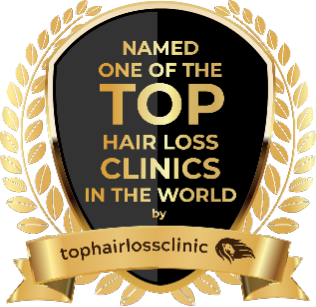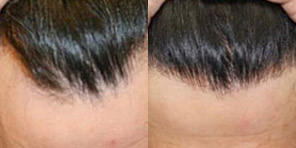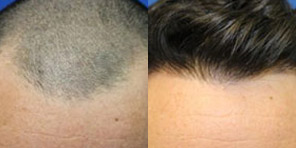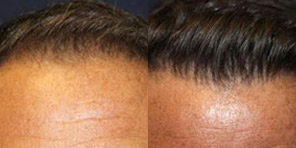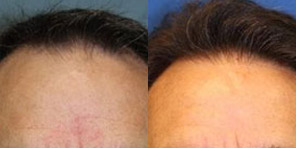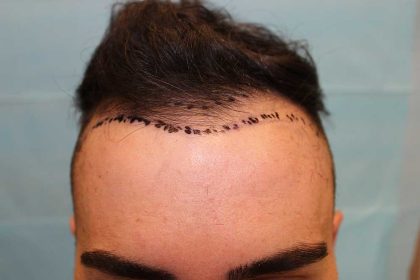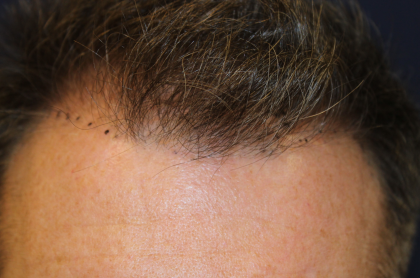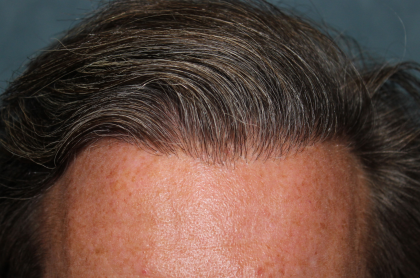Forehead reduction with hair transplants is a procedure that combines the artistry of facial aesthetics and the precision of Follicular Unit Extraction (FUE) hair transplantation. This innovative approach addresses concerns such as a high or disproportionately large forehead, receding hairline, or a masculine hairline that may not align with your desired aesthetic.
At CaliforniaHairMD, Dr. Richard Chaffoo, America’s First Triple Board-Certified Hair Transplant Plastic Surgeon , offers patients the opportunity to achieve their desired forehead shape and hairline through this advanced procedure. With years of experience and expertise, Dr. Chaffoo understands the intricate balance between facial harmony and hairline placement, ensuring natural-looking results that enhance your overall appearance.
If you feel that your forehead size or hairline is affecting your self-esteem or overall facial harmony, we invite you to schedule a consultation with Dr. Chaffoo at our La Jolla, San Diego, Newport Beach, or Beverly Hills practice. During your personalized consultation, Dr. Chaffoo will assess your unique facial features, discuss your goals and expectations, and create a customized treatment plan tailored to your specific needs.
To begin your journey towards a more balanced and harmonious facial appearance, contact CaliforniaHairMD at (800) 373-4773 or send us an inquiry to learn more about forehead reduction with hair transplants and schedule your consultation today.
Contents
Before and After Photos
What Determines Your Hairline?
Approximately 25% of men aged 40-55 and 31% of men aged 65-69 have a receding hairline. (1) A person’s hairline is influenced by various factors that can determine its shape, density, and position. Understanding these determinants can shed light on the complexity of hair growth patterns and provide insight into potential solutions for those seeking to enhance their hairline. Factors that affect the hairline include the following.
- Genetics: The genes inherited from our parents can influence the characteristics of our hair, including its thickness, texture, and placement on the scalp. Some individuals may have a naturally high or low hairline due to genetic predisposition.
- Hormonal Changes: Hormones, such as testosterone and estrogen, can impact hair growth and affect the positioning of the hairline. For example, hormonal imbalances or fluctuations during puberty, pregnancy, or menopause can lead to changes in hair density and alter the hairline’s appearance.
- Aging Process: As we age, our hair follicles undergo natural changes, resulting in thinning hair and receding hairlines. The aging process can cause a gradual shift in the hairline, making it appear higher or more recessed.
- Nutritional Deficiencies: A lack of essential nutrients, such as vitamins, minerals, and proteins, can contribute to hair loss and affect the health of the hairline. Maintaining a balanced diet rich in these nutrients is vital for optimal hair growth.
- Scalp Conditions: Certain scalp conditions, such as alopecia areata or scalp psoriasis, can lead to hair loss and affect the appearance of the hairline. Treating these conditions promptly can help maintain a healthy hairline.
- Stress Levels: Chronic stress can disrupt the hair growth cycle and potentially lead to hair loss. High stress levels may contribute to changes in the hairline’s density and position.
- Certain Medications: Some medications, such as chemotherapy drugs or certain antidepressants, can cause temporary or permanent hair loss, impacting the hairline’s appearance.
- Hair Care Practices: Excessive heat styling, tight hairstyles, and harsh chemical treatments can damage the hair follicles and contribute to hair loss or thinning, affecting the hairline.
- Autoimmune Disorders: Autoimmune disorders, such as alopecia areata or lupus, can lead to hair loss and affect the hairline’s appearance.
What is FUE and How Can it Help?
FUE is a minimally invasive procedure that involves the extraction of individual follicular units (1-4 hairs) from a donor area, typically the back or sides of the scalp, and their transplantation to the targeted areas, such as the frontal hairline. (2) This technique offers several benefits for individuals seeking to reduce the size of their forehead and restore a more natural-looking hairline.
NeoGraft
NeoGraft utilizes advanced “no-touch” technology to carefully extract individual follicular units from the donor area and implant them into the desired recipient site. It uses a suction-assisted motorized device and advanced precision punches to harvest hair for transplantation. This technique ensures that the transplanted hair blends seamlessly with the existing hair, creating a seamless and undetectable outcome.
ARTAS
During the ARTAS hair transplantation procedure, the robotic arm scans the patient’s scalp, identifying and selecting the most appropriate follicular units for transplantation. The system then extracts these follicles using a tiny punch tool, leaving behind tiny, virtually undetectable incisions that heal seamlessly without sutures. The harvested hair follicles are carefully implanted robotically into the recipient area, recreating a natural hairline.
SmartGraft
SmartGraft employs automated follicular unit extraction (FUE), a precise harvesting technique that ensures the preservation of each individual hair graft. This meticulous approach allows for the transplantation of healthy hair follicles from the donor area to areas of thinning or baldness, enabling the growth of new, natural hair.
If you have any questions about FUE, and would like to receive information about getting the hairline you desire, book an appointment with Dr. Chaffoo. Call (800) 373-4773 or use our simple inquiry form to get in touch.
Benefits of FUE
- Provides precise control over the placement of transplanted hair follicles
- Avoids a long, linear scar along the back and sides of the head
- Creates a customized hairline that suits the patient’s unique facial features
- Strategically implants the hair follicles in the forehead region with precision and a high graft survival rate
- Improves the overall proportion and balance of the face
- Tailored to meet each patient’s specific needs
Whether the goal is to lower the hairline, fill in receding temples, or add density to the frontal scalp, FUE can address these concerns effectively. The procedure can be performed using local anesthesia, ensuring minimal discomfort during the process. Additionally, the recovery period is relatively short, allowing patients to resume their normal activities within a few days.
Candidates for FUE
Candidates for forehead reduction with hair transplants are individuals who are unhappy with the size or shape of their forehead and desire a lower, more proportional hairline. This procedure is particularly beneficial for those experiencing a high or receding hairline, as it can effectively address both aesthetic concerns.
The ideal candidate for forehead reduction with hair transplants is in good overall health, has realistic expectations for the outcome of the procedure, and is committed to following post-operative care instructions. It is important for candidates to have sufficient donor hair on the scalp or be willing to consider alternative methods of hair transplantation if needed.
Personal Consultation
A personal consultation at CaliforniaHairMD in San Diego, La Jolla, Newport Beach, or Beverly Hills is the first step towards achieving your desired forehead reduction with hair transplants. During this consultation, Dr. Chaffoo will take the time to understand your unique medical history and cosmetic concerns. By carefully examining your forehead, hairline, and the rest of your scalp, he will assess the extent of your hair loss, the shape, and size of your forehead, and determine the best approach for your individual needs.
During your consultation, Dr. Chaffoo will discuss the techniques available for forehead reduction with FUE. He will explain the benefits and potential risks associated with each procedure, ensuring that you are well-informed and comfortable with your decision.
Cost of Forehead Reduction with Hair Transplants
The cost of a forehead reduction with hair transplants can vary depending on several factors. Each patient’s treatment plan is unique, and factors such as the techniques used, the number of grafts harvested, and the overall goals of the patient will determine the cost.
If you are considering forehead reduction with FUE hair transplantation, we encourage you to reach out to our practice by calling (800) 373-4773 or by using our inquiry form. Our friendly staff will be happy to address any questions or concerns you may have and assist you in scheduling a personal consultation with Dr. Chaffoo.
Read more about FUE and the latest news in hair transplantation on Dr. Chaffoo’s blog.
FAQ
How long does it take to see the final results of forehead reduction with hair transplants?
The transplanted hair follicles will initially shed within a few weeks after the procedure. However, new hair growth will begin within a few months. It takes approximately 9 to 12 months to see the full and final results of the forehead reduction with hair transplants, as the transplanted hair gradually grows and matures.
Is forehead reduction with hair transplants a permanent solution?
Yes, forehead reduction with hair transplants offers a permanent solution for addressing a receding hairline or high forehead. The transplanted hair follicles are resistant to the effects of DHT (dihydrotestosterone), the hormone responsible for hair loss, ensuring long-lasting and natural-looking results.
What is the recovery process like after forehead reduction with hair transplants?
Following the procedure, patients may experience some swelling, bruising, and mild discomfort in the treated area. These side effects typically subside within a few days to one week. It is important to follow post-operative instructions provided by your surgeon to ensure optimal healing and minimize any potential complications.
References
- Cranwell W, Sinclair R. Male Androgenetic Alopecia. Nih.gov. Published February 29, 2016. https://www.ncbi.nlm.nih.gov/books/NBK278957/
- Sharma R, Ranjan A. Follicular Unit Extraction (FUE) Hair Transplant: Curves Ahead. Journal of Maxillofacial & Oral Surgery. 2019;18(4):509-517. doi:https://doi.org/10.1007/s12663-019-01245-6

